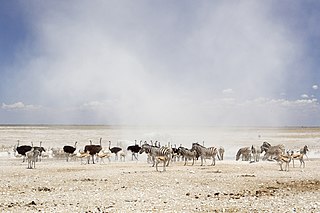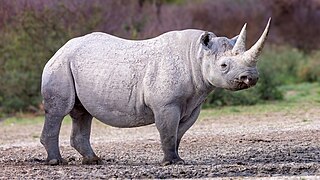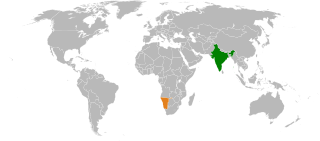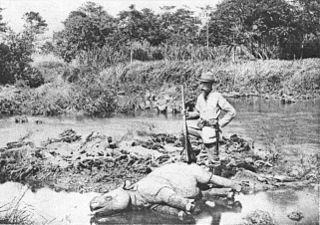Contents
| |||||
| Decades: | |||||
|---|---|---|---|---|---|
| See also: | |||||
Events in the year 2023 in Namibia .
| |||||
| Decades: | |||||
|---|---|---|---|---|---|
| See also: | |||||
Events in the year 2023 in Namibia .
Ongoing – COVID-19 pandemic in Namibia

Etosha National Park is a national park in northwestern Namibia and one of the largest national parks in Africa. It was proclaimed a game reserve in March 1907 in Ordinance 88 by the Governor of German South West Africa, Friedrich von Lindequist. It was designated as Wildschutzgebiet in 1958, and was awarded the status of national park in 1967, by an act of parliament of the Republic of South Africa. It spans an area of 22,270 km2 (8,600 sq mi) and was named after the large Etosha pan which is almost entirely within the park. With an area of 4,760 km2 (1,840 sq mi), the Etosha pan covers 23% of the total area of the national park. The area is home to hundreds of species of mammals, birds and reptiles, including several threatened and endangered species such as the black rhinoceros. Sixty-one black rhinoceros were killed during poaching in Namibia during 2022, 46 of which were killed in Etosha.

The black rhinoceros is a species of rhinoceros, native to eastern Africa and southern Africa, including Angola, Botswana, Kenya, Malawi, Mozambique, Namibia, South Africa, Eswatini, Tanzania, Zambia, and Zimbabwe. Although the species is referred to as black, its colours vary from brown to grey. It is the only extant species of the genus Diceros.

The president of the Republic of Namibia is the head of state and the head of government of Namibia. The president directs the executive branch of the Government of Namibia, as chair of the Cabinet and is the commander-in-chief of the armed forces, according to the Constitution of Namibia.

A rhinoceros, commonly abbreviated to rhino, is a member of any of the five extant species of odd-toed ungulates in the family Rhinocerotidae; it can also refer to a member of any of the extinct species of the superfamily Rhinocerotoidea. Two of the extant species are native to Africa, and three to South and Southeast Asia.

The Indian rhinoceros, also known as the greater one-horned rhinoceros, great Indian rhinoceros, or Indian rhino for short, is a rhinoceros species native to the Indian subcontinent. It is the second largest extant species of rhinoceros, with adult males weighing 2.07–2.2 tonnes and adult females 1.6 tonnes. The skin is thick and is grey-brown in colour with pinkish skin folds. They have a single horn on their snout that grows to a maximum of 57.2 cm (22.5 in). Their upper legs and shoulders are covered in wart-like bumps, and aside from the eyelashes, ear fringes and tail brush, Indian rhinoceroses are nearly hairless.

The white rhinoceros, white rhino or square-lipped rhinoceros is the largest extant species of rhinoceros. It has a wide mouth used for grazing and is the most social of all rhino species. The white rhinoceros consists of two subspecies: the southern white rhinoceros, with an estimated 16,803 wild-living animals, and the much rarer northern white rhinoceros. The northern subspecies has very few remaining individuals, with only two confirmed left in 2018. Sudan, the world's last known male northern white rhinoceros, died in Kenya on 19 March 2018 at age 45.
The WILD Foundation is a 501(c)(3) organization that was founded in 1974 by two South Africans and based in Boulder, Colorado.

Hage Gottfried Geingob was a Namibian politician who served as the third president of Namibia and Commander-in-Chief of the Namibian Defence Force (NDF) from 2015 until his death in February 2024. Geingob was the first Prime Minister of Namibia from 1990 to 2002, and served as prime minister again from 2012 to 2015. Between 2008 and 2012 Geingob served as Minister of Trade and Industry. In November 2014, Geingob was elected president of Namibia by an overwhelming margin. In November 2017, Geingob became the third president of the ruling SWAPO Party after winning by a large margin at the party's sixth Congress. He served as the party's president until his death. In August 2018, Geingob began a one-year term as chairperson of the Southern African Development Community.

The south-central black rhinoceros, also known as the south-central hook-lipped rhinoceros or the lesser black rhino, is a subspecies of the black rhinoceros. In keeping with the rules of zoological nomenclature, the south-central black rhinoceros should be known as Diceros bicornis keitloa, a nomen novum. Although it is the most numerous of the black rhinoceros subspecies, it is nevertheless designated as critically endangered on the IUCN Red List. Like other black rhinoceros subspecies, it has a prehensile lip and lives in savanna habitat.

The south-western black rhinoceros is a subspecies of the black rhinoceros, living in southwestern Africa. It is currently listed as near threatened by the IUCN. The biggest threat towards the subspecies is illegal poaching.

The International Rhino Foundation (IRF) is a Texas-based charity focused on the conservation of the five species of rhinoceros which include the White Rhinoceros and Black Rhinoceros of Africa, and the Indian Rhinoceros, Javan Rhinoceros and Sumatran Rhinoceros of Asia.

Saara Kuugongelwa-Amadhila is a Namibian politician who has served as the Prime Minister of Namibia since 2015. She is a member of the South West Africa People's Organization (SWAPO) and has been a member of the National Assembly of Namibia since 1995. She served as Minister of Finance from 2003 to 2015. She is the first woman to serve as Prime Minister of Namibia.

Netumbo Nandi-Ndaitwah is a Namibian politician who is Namibia's third and current vice president since February 2024. She previously served as the deputy prime minister of Namibia from 2015 to 2024. Currently the SWAPO vice president, and has retained her position and is set to become the party's first female presidential candidate in November 2024. She has also served as Namibia's Minister of International Relations and Cooperation since December 2012. From March 2010 to December 2012, she was Minister of Environment and Tourism. Nandi-Ndaitwah is a member of SWAPO, Namibia's ruling party, and a long-time member of the National Assembly. In 2017, Nandi-Ndaitwah was elected vice-president of the Swapo Party at the party's 6th Congress. She is the first woman to serve in that position.

The Cabinet of Namibia is an appointed body that was established by Chapter 6 of the Constitution of Namibia. It is mandated to include the following positions: the President of Namibia, the Prime Minister of Namibia and any positions that the President so appoints.

India–Namibia relations are the current and historical relations between India and Namibia. India has a high commissioner in Windhoek and Namibia has a high commissioner in New Delhi. Namibia's high commissioner is also accredited for Bangladesh, the Maldives and Sri Lanka. In 2010, relations were described by Indian officials as "warm and cordial".

Bomo Edith Edna Molewa, formerly known as Edna Sethema, was a South African politician and member of the African National Congress. Molewa became the Minister of Water and Environmental Affairs of South Africa on 31 October 2010, as part of a cabinet reshuffle by President Jacob Zuma. On 25 May 2014 her Ministry has been divided and she was appointed Minister of Environmental Affairs. She succeeded Buyelwa Sonjica. Prior to her death, Molewa was studying towards a Bachelor's of Arts Honours in Developmental Studies through the University of South Africa.

The southern white rhinoceros or southern white rhino is one of the two subspecies of the white rhinoceros. It is the most common and widespread subspecies of rhinoceros.
Wildlife Angel is a wildlife protection non-governmental organization (NGO) based in Strasbourg (France). Its three main objectives are to protect wildlife, to protect rangers and to fight poaching by intervening in national parks, private reserves and working with other non-governmental organizations (NGO). Wildlife Angel intervenes directly in the field with rangers in charge of animal protection.

The wildlife trafficking network in southern Africa involves the illicit extraction, transportation and transaction of wildlife within and across the nations of Botswana, Lesotho, Namibia, South Africa and Eswatini. Involvement in the illegal trading network can be divided into three general roles: poachers, traffickers and intermediaries, and consumers. There are a wide range of motives depending on an individual's role in the network. Some motivations include profit, sustenance, and reducing human-wildlife conflict.

Rhinoceros poaching in southern Africa is the illegal act of slaughtering rhinoceros in the southern African countries of Namibia, Botswana, Zimbabwe and South Africa, where most of Africa's rhinos live. The most common reason for rhino poaching is to meet the high demand for their horns in Asian countries, where the horn is predominantly used in Traditional Chinese Medicine but is increasingly being used as a symbol of wealth and prosperity. In previous generations, the most common rhino poaching activity was hunting for recreational purposes. Because of excessive poaching, rhino populations have decline rapidly since the 1970s, leaving some species critically endangered and facing extinction.